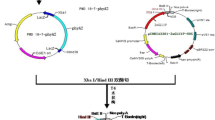Abstract
The expression of a microbial phytase in transgenic plants may create a new biochemical pathway that mobilizes its endogenous phytate and release inorganic phosphate from it, so that more phosphorus is available for plant growth. In this study, transgenic soybean plants were generated via both Agrobacterium transformation and pollen tube pathway with the PhyA gene of Aspergillus ficuum. The optimal concentrations of plant hormones including N6-benzylaminopurine (BAP), gibberellin (GA3) and indole-3-butyric acid (IBA) were tested based on their effectiveness on promoting the growth of transgenic explants. Genomic PCR results and Southern blot hybridization analysis showed that transgenic soybean plants selected for resistance to kanamycin contained the phyA transgene. The transgenic soybean plants with phyA gene integrated in their genome exhibited lower amount of phytate in different soybean tissues including leaf, stem and root, which indicated that engineering crop plants with a higher expression level of heterologous phytase could improve the degradation of phytate and potentially in turn mobilize more inorganic phosphate from phytate and thus reduce phosphate load on agricultural ecosystems.



Similar content being viewed by others
References
Abelson PH (1999) A potential phosphate crisis. Science 283:2015
Balestri E, Lardicci C (2006) Stimulation of root formation in Posidonia oceanica cuttings by application of auxins (NAA and IBA). Mar Biol 149:393–400
Barrientos L, Scott JJ, Murthy PP (1994) Specificity of hydrolysis of phytic acid by alkaline phytase from lily pollen. Plant Physiol 106:1489–1495
Brinch-Pedersen H, Hatzack F (2006) Analysis of phosphorus and phosphorylated compounds in the context of plant physiology and global phosphorus management: a review. Curr Anal Chem 2:421–430
Cao L, Wang WM, Yang CT, Yang Y, Diana J, Yakupitiyage A, Luo Z, Li DP (2007) Application of microbial phytase in fish feed. Enzyme Microb Technol 40:497–507
Cheryan M (1980) Phytic acid interactions in food systems. Crit Rev Food Sci Nutr 13:297–335
Chiera JM, Finer JJ, Grabau EA (2004) Ectopic expression of a soybean phytase in developing seeds of Glycine max to improve phosphorus availability. Plant Mol Biol 56:895–904
Cho MJ, Widholm JM, Vodkin LO (1995) Cassettes for seed-specific expression tested in transformed embryogenic cultures of soybean. Plant Mol Biol Rep 13:255–269
Da Silva LG, Trugo LC, Terzi SD, Couri S (2005) Low phytate lupin flour based biomass obtained by fermentation with a mutant of Aspergillus niger. Process Biochem 40:951–954
Di R, Purcell V, Collins GB, Ghabrial SA (1996) Production of transgenic soybean lines expressing the bean pod mottle virus coat protein precursor gene. Plant Cell Rep 15:746–750
Dvorakova J, Kopecky J, Havlicek V, Kren V (2000) Formation of myo-inositol phosphates by Aspergillus niger 3-phytase. Folia Microbiol 45:128–132
Emery RJN, Pearce DW, Pharis RP, Reid DM, Chinnappa CC (2001) Stem elongation and gibberellins in alpine and prairie ecotypes of Stellaria longipes. Plant Growth Regul 35:17–29
Ercisli S, Esitken A, Sahin F (2004) Exogenous IBA and inoculation with Agrobacterium rubi stimulate adventitious root formation on hardwood stem cuttings of two rose genotypes. Hortscience 39:533–534
Finnegan J, McElroy D (1994) Transgenic inactivation: plants fight back! Biotechnology 12:883–888
Fu SJ, Sun JY, Qian LC, Li ZY (2008) Bacillus phytases: present scenario and future perspectives. Appl Biochem Biotechnol 151:1–8
Gao XR, Wang GK, Su Q, Wang Y, An LJ (2007) Phytase expression in transgenic soybeans: stable transformation with a vector-less construct. Biotechnol Lett 29:1781–1787
Gibson DM, Ullah AH (1988) Purification and characterization of phytase from cotyledons of germinating soybean seeds. Arch Biochem Biophys 260:503–513
Greiner R, Konietzny U (2006) Phytase for food application. Food Technol Biotechnol 44:125–140
Haefner S, Knietsch A, Scholten E, Braun J, Lohscheidt M, Zelder O (2005) Biotechnological production and applications of phytases. Appl Microbiol Biotechnol 68:588–597
Hamano M, Yamato Y, Yamazaki H, Miura H (2002) Endogenous gibberellins and their effects on flowering and stem elongation in cabbage (Brassica oleracea var capitata). J Hortic Sci Biotechnol 77:220–225
Lei XG, Porres JM (2003) Phytase enzymology, applications, and biotechnology. Biotechnol Lett 25:1787–1794
Lung SC, Chan WL, Yip W, Wang LJ, Yeung EC, Lim BL (2005) Secretion of beta-propeller phytase from tobacco and Arabidopsis roots enhances phosphorus utilization. Plant Sci 169:341–349
Sanghai-Maroof MA, Soliman KM, Jorgensen A, Allard RW (1984) Ribosomal DNA spacer-length polymorphisms in barley: Mendelian inheritance, chromosomal location, population dynamics. Proc Natl Acad Sci USA 81:8014–8018
Sharma J, Knox GW, Ishida ML (2006) Adventitious rooting of stem cuttings of yellow-flowered Magnolia cultivars is influenced by time after budbreak and indole-3-butyric acid. HortScience 41:202–206
Tye AJ, Siu FKY, Leung TYC, Lim BL (2002) Molecular cloning and the biochemical characterization of two novel phytases from B. subtilis 168 and B. licheniformis. Appl Microbiol Biotechnol 59:190–197
Urbano G, López-Jurado M, Aranda P, Vidal-Valverde C, Tenorio E, Porres J (2000) The role of phytic acid in legumes: antinutrient or beneficial function? J Physiol Biochem 56:283–294
Wilcox JR, Premachandra GS, Young KA, Raboy V (2000) Isolation of high inorganic P, low-phytate soybean mutants. Crop Sci 40:1601–1605
Yang QK, Cao YP, Cui Y (2002) Study on introducing Bt gene into soybean by pollen tube path method. Chin J Oil Crop Sci 24:17–20
Yip W, Wang LJ, Cheng CW, Wu WL, Lung SC, Lim BL (2003) The introduction of a phytase gene from Bacillus subtilis improved the growth performance of transgenic tobacco. Biochem Biophys Res Commun 310:1148–1154
Acknowledgments
The Project Supported by Natural Science Foundation of Hebei Province (C2009000868) and Project of Transgenic Crops of Ministry Science and Technology Development of China (2009ZX08004-004B).
Author information
Authors and Affiliations
Corresponding author
Rights and permissions
About this article
Cite this article
Yang, S., Li, G., Li, M. et al. Transgenic soybean with low phytate content constructed by Agrobacterium transformation and pollen-tube pathway. Euphytica 177, 375–382 (2011). https://doi.org/10.1007/s10681-010-0262-4
Received:
Accepted:
Published:
Issue Date:
DOI: https://doi.org/10.1007/s10681-010-0262-4




